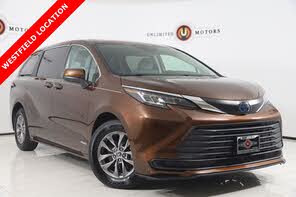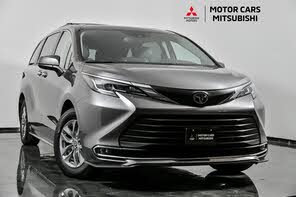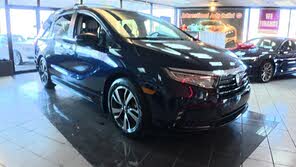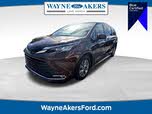2021 Toyota Sienna vs 2021 Honda Odyssey
Overview | |
MSRP$31,790 | MSRP$34,460 |
Listings254 | Listings688 |
Ratings & Reviews | |
User Reviews | User Reviews |
Expert reviews7.8 out of 10 | Expert reviews8.3 out of 10 |
Pros
Cons
| Pros
Cons
|
2021 Honda Odyssey Reviews SummaryWhen you’re raising kids, the last thing your life needs is added complication. The modern minivan is designed to eliminate snags, simplify your existence, and reduce friction in the daily grind. Whether you wish to save money on gas, carry maximum cargo, or own a vehicle that is ridiculously easy to load (whether we’re talking passengers or merchandise), a minivan makes good sense. And the freshened 2021 Honda Odyssey is one of our favorites, for now. | |
2021 Toyota Sienna Reviews SummaryToyota’s minivan got a major makeover for 2021, now entering its fourth generation of production since debuting as a 1997 model. For the first time, the Sienna gets a hybrid gasoline-electric powertrain, and not only that—it’s standard equipment. The Sienna Hybrid is built on the Toyota New Global Architecture (TNGA-K) platform, shared with the Highlander and other current Toyota models. | |
Popular Features & Specs | |
Engine3.5L 280 hp V6 | Engine2.5L 245 hp I4 Hybrid |
Drive TrainFWD | Drive TrainFWD |
Seating Capacity7 | Seating Capacity8 |
Horsepower280 hp @ 6000 rpm | Horsepower |
EV Battery Capacity | EV Battery Capacity1.9 kWh |
MPG City19 | MPG City36 |
MPG Highway28 | MPG Highway36 |
Engine | |
Engine Name3.5L 280 hp V6 | Engine Name2.5L 245 hp I4 Hybrid |
Torque262 lb-ft @ 4700 rpm | Torque |
Horsepower280 hp @ 6000 rpm | Horsepower |
DrivetrainFWD | DrivetrainFWD |
Fuel Economy | |
EV Battery Capacity | EV Battery Capacity1.9 kWh |
MPG City19 | MPG City36 |
MPG Highway28 | MPG Highway36 |
Interior | |
Seating Capacity7 | Seating Capacity8 |
Safety | |
Front Crash Overall5 | Front Crash Overall4 |
Side Crash Overall5 | Side Crash Overall5 |
Dimensions & Capacity | |
Cargo Space32.8 cu ft | Cargo Space33.5 cu ft |
Curb Weight4398 lbs | Curb Weight4610 lbs |
Height68.3 in | Height68.5 in |
Length205.2 in | Length203.7 in |
Width92.3 in | Width78.5 in |
Wheelbase118.1 in | Wheelbase120.5 in |
Maximum Payload1621 lbs | Maximum Payload1560 lbs |
Number of doors4 | Number of doors4 |
Maximum Towing Capacity3500 lbs | Maximum Towing Capacity3500 lbs |
Overview | ||
MSRP | $31,790 | $34,460 |
Listings | ||
Ratings & Reviews | ||
User reviews | ||
Expert reviews | 7.8 out of 10Read full review | 8.3 out of 10Read full review |
Pros & cons | Pros
Cons
| Pros
Cons
|
Summary | When you’re raising kids, the last thing your life needs is added complication. The modern minivan is designed to eliminate snags, simplify your existence, and reduce friction in the daily grind. Whether you wish to save money on gas, carry maximum cargo, or own a vehicle that is ridiculously easy to load (whether we’re talking passengers or merchandise), a minivan makes good sense. And the freshened 2021 Honda Odyssey is one of our favorites, for now. | Toyota’s minivan got a major makeover for 2021, now entering its fourth generation of production since debuting as a 1997 model. For the first time, the Sienna gets a hybrid gasoline-electric powertrain, and not only that—it’s standard equipment. The Sienna Hybrid is built on the Toyota New Global Architecture (TNGA-K) platform, shared with the Highlander and other current Toyota models. |
Video | ||
Popular Features & Specs | ||
Engine | 3.5L 280 hp V6 | 2.5L 245 hp I4 Hybrid |
Drive Train | FWD | FWD |
Seating Capacity | 7 | 8 |
Horsepower | 280 hp @ 6000 rpm | |
EV Battery Capacity | 1.9 kWh | |
MPG City | 19 | 36 |
MPG Highway | 28 | 36 |
Engine | ||
Engine Name | 3.5L 280 hp V6 | 2.5L 245 hp I4 Hybrid |
Torque | 262 lb-ft @ 4700 rpm | |
Horsepower | 280 hp @ 6000 rpm | |
Drivetrain | FWD | FWD |
Fuel Economy | ||
EV Battery Capacity | 1.9 kWh | |
MPG City | 19 | 36 |
MPG Highway | 28 | 36 |
Interior | ||
Seating Capacity | 7 | 8 |
Safety | ||
Front Crash Overall | 5 | 4 |
Side Crash Overall | 5 | 5 |
Dimensions & Capacity | ||
Cargo Space | 32.8 cu ft | 33.5 cu ft |
Curb Weight | 4398 lbs | 4610 lbs |
Height | 68.3 in | 68.5 in |
Length | 205.2 in | 203.7 in |
Width | 92.3 in | 78.5 in |
Wheelbase | 118.1 in | 120.5 in |
Maximum Payload | 1621 lbs | 1560 lbs |
Number of doors | 4 | 4 |
Maximum Towing Capacity | 3500 lbs | 3500 lbs |
The 2021 Honda Odyssey retained a familiar aesthetic that had been prevalent for about a decade, but subtle tweaks for the model year refreshed its look. The front grille and bumper were redesigned, while all trim levels came standard with LED headlights featuring automatic high-beam operation. At the back, a gloss black spear with a chrome insert spanned the taillights, adding a modern touch. Additionally, new wheel designs debuted for the top three trim levels. These enhancements were aimed at updating the Odyssey’s appearance by minimizing the brightwork.
Consumers had five trim levels to choose from: LX, EX, EX-L, Touring, and Elite, with base prices ranging from $31,790 to $47,820, excluding destination charges. Select colors also incurred an additional $395 fee. Our test vehicle, an Elite trim in Lunar Silver Metallic, came with a price tag of $48,940, including a $1,120 destination charge. The Elite trim featured new perforated leather upholstery with contrast stitching and piping, and ambient dashboard lighting, lending a high-end feel to the interior. With handsome new 19-inch wheels and reduced chrome accents, the Odyssey Elite positioned itself closer to luxury minivans.
Conversely, the 2021 Toyota Sienna sought to redefine minivan styling with a more SUV-like appearance. The wide grille emphasized its width, complemented by sleek LED headlamp arrays integrated into a horizontal panel with a prominent Toyota logo. Its side profile was assertive, thanks to the reworked sliding side doors that bulged over the rear wheels, achieved through rethought hinges and slides. Alloy wheels varied from 17-inch to 20-inch, depending on the trim, and added to the bold look.
Inside, the Sienna continued the horizontal emphasis, giving a sense of width. The seating position was higher than a sedan's, ensuring comfort without the towering height of an SUV. The dashboard was uncluttered, with controls placed just below the infotainment screen. The "bridge" center console formed a convenient tray beneath it, large enough to house a handbag. The materials throughout the cabin were high-quality, enhancing the premium feel. Both the second and third rows offered ample comfort and space, with the second row’s sliding capability allowing for easy access to the third row.


















The 2021 Honda Odyssey was equipped with a 3.5-liter V6 engine mated to a ten-speed automatic transmission, delivering 280 horsepower to the front wheels. This drivetrain provided smooth and effortless power, with variable cylinder management technology conserving fuel by operating on fewer cylinders when conditions allowed. The EPA rated it at 22 mpg in combined driving, and real-world testing showed it achieved an average of 21.8 mpg.
Although AWD was not available—a disadvantage compared to competitors like Chrysler and Toyota—the Odyssey featured a new electronic brake booster for improved low-speed adaptive cruise control capability and enhanced brake pedal feel and response. While generally providing an enjoyable driving experience with perfectly weighted steering and firm but comfortable ride quality, the brakes showed limitations under stress, especially descending mountain grades, suggesting the need for a braking system upgrade.
The 2021 Toyota Sienna Hybrid introduced a new hybrid powertrain, combining a 2.5-liter four-cylinder engine with two electric motors for a total output of 243 horsepower. The setup, similar to the Highlander Hybrid’s, included FWD as standard and optional AWD, achieved through a separate electric motor driving the rear wheels, streamlining the mechanical design.
The Sienna utilized an electronically controlled CVT, which prioritized fuel efficiency over throttle response and driving excitement. It offered four selectable drive modes—Normal, EV, Eco, and Sport—with Sport mode offering only a modest increase in responsiveness. The new TNGA front suspension and rear independent trailing arm system markedly improved handling and ride quality, reducing body roll and ensuring a comfortable driving experience.
Fuel economy was a highlight, with EPA ratings of 36 mpg city, 36 mpg highway, and 36 mpg combined for FWD, while AWD models achieved 35/36/35 mpg combined, making the Sienna Hybrid a highly efficient choice.
The interior of the Honda Odyssey was designed for practicality, with clear instrumentation, logical controls, and ample storage. A 12-way power-adjustable driver’s seat, available in all trims except the base LX, provided substantial comfort, while the Elite trim added a heated steering wheel and heated and ventilated front seats. The front passenger seat lacked height adjustment but still offered good thigh support.
The standout feature was the Magic Slide second-row seat layout, allowing diverse configurations for optimal comfort and space. Though accommodating third-row seats and various storage compartments were highlights, the need to physically remove the second-row seats to maximize cargo space to 144.9 cubic feet was a drawback. The base LX trim had 32.8 cubic feet behind the third row and expanded to 88.8 cubic feet with the third row folded.
The Toyota Sienna excelled in providing convenience for all passengers, featuring a standard third-row 60/40-split bench that easily folded into the floor, and a second-row that slid up to 25 inches for easy third-row access. The cabin came equipped with multiple storage cubbies, cupholders, and bottle holders spread across all seating rows, totaling up to 16 cupholders.
Cargo capacity was versatile, with 33.5 cubic feet behind the third row, 75.2 cubic feet behind the second row, and up to 101.0 cubic feet behind the first row. Unlike the Odyssey, the Sienna’s second row did not need to be removed to adjust cargo space, enhancing convenience. The hybrid battery was efficiently placed under the front seats, ensuring it did not intrude on cargo space, and the Sienna could tow up to 3,500 pounds.
Starting with the EX trim, the Honda Odyssey boasted an 8-inch touchscreen infotainment system with Apple CarPlay, Android Auto, satellite radio, HD Radio, text-messaging support, and basic HondaLink connectivity. Higher trims added features like navigation, WiFi capability, CabinWatch, CabinTalk, a premium sound system, and wireless smartphone charging. The rear-seat entertainment system included a single 10.2-inch screen, Blu-Ray player, wireless headphones, and streaming apps, though its lack of a touchscreen was a minor inconvenience.
For connectivity, HondaLink came with various subscription plans offering safety, remote operation, and concierge services. Despite an extensive technology suite, the absence of a tuning knob and subpar voice-recognition technology were notable drawbacks, complicating user experience.
The 2021 Toyota Sienna came with a nine-inch touchscreen, standard Apple CarPlay, Android Auto, and Amazon Alexa, SiriusXM, and multiple USB ports. Connectivity features included Safety Connect, Remote Connect, Service Connect, and WiFi Connect trials, ensuring robust connectivity across all trims. Optional Qi-compatible charging, a 1500-watt inverter, and an advanced JBL audio system with 12 speakers elevated the Sienna’s tech experience.
Rear-seat entertainment featured an 11.6-inch 1080p display, a remote, wireless headphones, and HDMI input, ensuring a premium passenger experience. The driver enjoyed advanced tech like a color multi-information display, optional 10-inch Head-Up Display, and a digital rearview mirror, enhancing convenience and safety.
The Honda Odyssey improved its safety features for 2021, with Honda Sensing now standard on all trims. Enhanced with a new radar unit and LED headlights with automatic high-beams, it aimed to maintain its Top Safety Pick status from IIHS. Features like low-speed follow adaptive cruise control, pedestrian braking, and road-sign recognition were added to the suite. Despite its comprehensive safety features, the adaptive cruise control and lane-departure warning systems were not as smooth or intuitive as expected.
With top-five star ratings from NHTSA for most assessments, except for rollover resistance, the Odyssey remained a strong contender in safety.
The Toyota Sienna Hybrid featured Toyota Safety Sense 2.0, including dynamic radar cruise control, lane-tracing assist, pre-collision system, lane-departure alert, automatic high beams, and road sign assist. The Star Safety System added enhanced stability control, traction control, anti-lock brakes, and other features. The Sienna included 10 airbags, LATCH connectors, a rear-seat reminder system, and an updated tire spare tire location for greater safety and convenience.
While crash-test ratings for 2021 were not yet available, the 2020 Sienna achieved good ratings from IIHS for various criteria and a Five-Star Overall Rating from NHTSA.
CarGurus highlights

According to CarGurus experts, the overall rating for the 2021 Honda Odyssey was 7.8 out of 10, while the 2021 Toyota Sienna scored 8.3 out of 10. Based on these ratings, the Toyota Sienna emerged as the superior choice. It offered a compelling mix of fuel efficiency, advanced technology, innovative design, and robust safety features, making it a standout option in the minivan market.
Choose the 2021 Toyota Sienna if:
- You value fuel efficiency and eco-friendliness, thanks to the advanced hybrid powertrain.
- You seek a minivan with a more SUV-like design and bold exterior styling.
- You appreciate a high level of interior convenience, including versatile cargo and passenger space without requiring seat removal.
Choose the 2021 Honda Odyssey if:
- You prioritize a robust and reliable V6 engine with smooth power delivery.
- You desire flexible second-row seating for diverse passenger and cargo configurations.
- You prefer extensive connectivity and infotainment features, despite a few minor drawbacks.
CarGurus highlights

According to CarGurus experts, the overall rating for the 2021 Honda Odyssey was 7.8 out of 10, while the 2021 Toyota Sienna scored 8.3 out of 10. Based on these ratings, the Toyota Sienna emerged as the superior choice. It offered a compelling mix of fuel efficiency, advanced technology, innovative design, and robust safety features, making it a standout option in the minivan market.
Choose the 2021 Toyota Sienna if:
Shop Now- You value fuel efficiency and eco-friendliness, thanks to the advanced hybrid powertrain.
- You seek a minivan with a more SUV-like design and bold exterior styling.
- You appreciate a high level of interior convenience, including versatile cargo and passenger space without requiring seat removal.
Choose the 2021 Honda Odyssey if:
Shop Now- You prioritize a robust and reliable V6 engine with smooth power delivery.
- You desire flexible second-row seating for diverse passenger and cargo configurations.
- You prefer extensive connectivity and infotainment features, despite a few minor drawbacks.

By: CarGurus + AI
At CarGurus, our team of experienced automotive writers remain at the heart of our content operation, conducting hands-on car tests and writing insightful guides that are backed by years of industry experience. To complement this, we are harnessing AI to make our content offering more diverse and more helpful to shoppers than ever. To achieve this, our AI systems are based exclusively on CarGurus content, ratings and data, so that what we produce is both unique to CarGurus, and uniquely helpful to car shoppers.








































